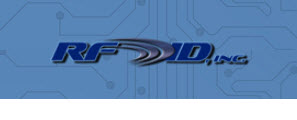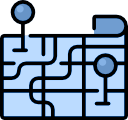RFID 101
What is RFID?
Radio Frequency Identification (RFID) is a small chip, or RFID tag, attached to some object that can be read at short range via radio waves by a tag reader. These items can be close together or far apart and are used for everything from credit cards, to inventory tracking to ticketing. Components can be broken down as a Tag (Transponder), a Reader, an Antenna, and sometimes an Interface. Sometimes the Reader and Antenna are enclosed into a single housing, sometimes they are 2 separate components. Sometimes there is added to this architecture an Interface which can translate data into other communication protocols and/or manage a network of many Readers.
What Types of Tags are There and What's the Difference?
Passive Tags
A Tag carrying data, which can be RO (read only) or RW (read write) lies dormant until it is activated by the RF signal of a Reader. Upon being woken or excited by the Reader, the Tags begins to transmit it’s data back to the Reader. Tags typically have an infinite life in terms of being read, and a finite life in terms of the amount of writes. 100k writes is typical.
Active Tags
A Tag that is battery powered, most of which are known as TTO (tag talk only) whereby the Tag continually transmits it’s data x amount of times per second, and if in range of a Reader, which is really more of a listening post, will be read. That range depends upon the frequency of the system, but our 433.92 MHz product operates up to several thousand meters. Tag life very much depends upon the size of the battery and number of data transmissions, but can be as high as 4 years.
What Else Will I Need Now That I know the Tags I'm Looking for?
Readers
Readers translate the 1’s and 0’s of Tag data into languages another machine or human can understand, like TTL or ASCII bytes. Readers can have other functions, like I/O, sound a horn, illuminate a light, etc., or even logic tasks. Most often Readers are capable of serial (RS232, RS485, RS422), USB, TTL, Wiegand and Ethernet communication protocols.
Interfaces
Although Readers could output more in depth language protocols, PLC languages, this would make a single Reader more expensive thus it makes more sense to network simple Readers and most often this is handled by an Interface which can also manage a network of Readers, each Reader having its own unique address. Typical are protocols specific to a particular PLC manufacturer like Ethernet/IP & DeviceNet (Allen Bradley PLC’s), Profibus & Profinet (Siemens), Modbus RTU and Modbus TCP (Modicon) although standard TCPIP Ethernet and serial communications can also be offered.
What frequency should I consider for my application?
First and foremost that depends upon the read range necessary, followed by, to what material will the Tag be mounted (metal or non-metal).
- 125 KHz LF passive & 13.56 MHz HF passive – read range of inches to a foot or two. 1 meter is possible but pushing the limits of the technology necessitating a large Tag and Antenna. LF is very metal friendly, HF not so much. See a full breakdown of LF vs. HF here.
- UHF active 433.92 MHz – read range of 1 meter to several thousand feet, some Tag options are metal mountable.
- UHF passive 868-928 MHz – read range of inches to 30 meters of range, some Tag options are metal mountable.





